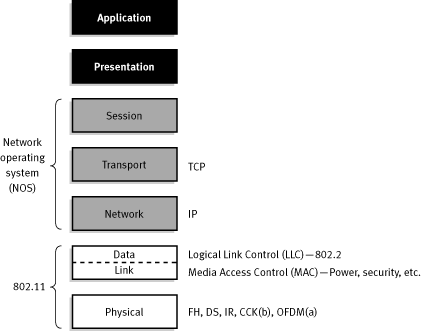Wireless, Everywhere
-- IEEE 802.11b High Rate Wireless Local Area
Networks
Contents††††††† Letís go wireless |
|
|
Project Background
Letís Go Wireless
When you hear the word "wireless," what comes to mind? For many, it means mobile phones. For others, it means indoor (mobile) wireless access to the Local Area Network. For still others, it means the ability to roam around the streets and freeways with a PDA or laptop and have constant access to the company network and/or the Internet.† One thing for sure, wireless never bothers with walls, ceilings or floors like wired network has to do.
Throwing away traditional cables, wireless networks rely on radio frequencies to transmit data between devices. For users, wireless networks work the same way as wired systems. Advantages include:
Ł Flexible infrastructure
Ł Ease of installation and operation
Ł Broader ranges
Ł Cost-savings over conventional wired-networking strategies
Ł Optional link to existing cabled networks and resources
History of 802.11b
In 1990, the Institute of Electrical and
Electronics Engineers (IEEE) established the 802.11 working group to create a
wireless local area network (WLAN) standard. A set of specifications was
produced for the physical and medium access control (MAC) layers of the OSI
model. The 2.4 GHz ISM (industrial, scientific and medical) band was chosen as
the operating frequency band with data rates of 1 and 2 Mbps. The IEEE realized
even then that in the future there would be an ever-increasing demand for high
data rates; the working group produced two supplements for higher data
rates. 802.11a specifies a maximum data rate of 54 Mbps in the Unlicensed
Natiaonal Information Infrastructure (UNII) 5 GHz band. 802.11b specifies data
rates of 5.5 and 11 Mbps at 2.4 GHz. They both have relatively identical MAC layers
but different modulation schemes - orthogonal frequency division multiplexing (OFDM) for 802.11a and direct sequence spread spectrum
(DSSS) for 802.11b.
The 802.11b supplement [2] was adopted in 1999 and in just two years there has been a fundamental shift from fixed networks to wireless networks. A lot of research is ongoing on ways to improve WLANs. The IEEE also created the Wireless Ethernet Compatibility Alliance (WECA) to ensure interoperability of WLAN products from different vendors. Products meeting the specifications are marked with the Wi-Fi sign (wireless fidelity) Members of WECA are drawn from the semiconductor industry, software vendors, pc manufacturers and networking companies. The major companies include IBM, 3Com, Apple, Lucent Technologies, Cabletron, Fujitsu, Intersil, Nokia, Breezecom and Samsung.
802.11b and ISO Model

Like all IEEE 802 standards, the 802.11 standards focus on the bottom two levels of the ISO model, the physical layer and the data link layer ( Figure 1). Any LAN application, network operating system, or protocol, including TCP/IP and Novell NetWare, will run on an 802.11-compliant WLAN as easily as they run over Ethernet.
The basic architecture, features, and services of 802.11b are defined by the original 802.11 standard. The 802.11b specification affects only the physical layer, adding higher data rates and more robust connectivity.
Standard Organizations
Institute of Electrical and
Electronics Engineers (IEEE) P802.11: Standards
working group on wireless local area networks. The working group is a part of
IEEE LMSC (LAN MAN Standards Committee) formerly called IEEE Project 802.
IEEE LMSC reports to the Standards Activity Board (SAB) of the IEEE Computer
Society.
Wireless Ethernet Compatibility Alliance (WECA): Provides certification of appliance with the IEEE 802.11Standard and ensures that products from multiple vendor meet strict requirements for interoperability.
Internet Engineering Task Force (IETF): specifies protocol enhancements that allow transparent routing of IP datagrams to mobile nodes in the Internet.†
Our workgroup
Lu (Lucia) Xia††††††††††††††††††††††††††††††††††††††251A, Fitzpatrick Hall (Tel) 631-9691††††††††††††††††††††††† |
Anthony (Tony) Ekpenyong
210, Cushing Hall (Tel) 631-7823 |
Last
revised: Oct.31, 2001

